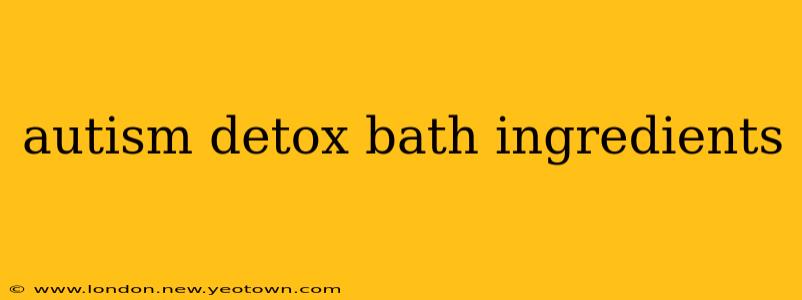Autism Detox Baths: Fact vs. Fiction – A Parent's Guide to Supporting Sensory Needs
The idea of an "autism detox bath" often surfaces in online forums and parenting groups. It's crucial to understand that autism isn't a toxin that needs to be removed from the body. Autism is a complex neurodevelopmental condition with diverse presentations. However, many autistic individuals experience sensory sensitivities that can be soothed and managed through carefully chosen bath practices. This isn't detoxification; it's about creating a calming and regulated sensory experience.
Let's explore the common claims and the science-backed approaches to creating a relaxing and beneficial bath for autistic children and adults.
What are the ingredients in an autism detox bath? (People Also Ask)
This question is misleading. There's no scientific basis for a "detox" bath specifically for autism. The ingredients suggested often focus on calming and soothing effects, not detoxification. Commonly mentioned ingredients include Epsom salts, baking soda, essential oils (lavender, chamomile), and colloidal oatmeal. However, the effectiveness and safety depend on individual sensitivities.
Do detox baths help with autism symptoms?
No, detox baths do not cure or treat autism. There is no scientific evidence to support this claim. However, certain bath ingredients can help manage some associated symptoms, particularly sensory sensitivities. For example, the warm water can be relaxing, while Epsom salts might ease muscle tension. But this isn't a cure; it's supportive care.
Are there any risks associated with detox baths for autistic individuals?
Yes, there are potential risks. Some individuals may have allergies or sensitivities to certain bath ingredients. Essential oils, in particular, should be used with extreme caution, especially with young children or those with respiratory conditions. Always perform a patch test before a full bath. Overheating is another concern; the water should be lukewarm, not hot. Finally, some individuals might find the experience overwhelming rather than calming, highlighting the importance of individualized approaches.
What are safe and effective bath practices for autistic children and adults?
Focus on creating a sensory-friendly environment. This means:
- Temperature Control: Use lukewarm water, checking the temperature frequently.
- Sensory Input: Consider adding calming scents like lavender or chamomile only if tolerated. Always dilute essential oils properly and do a patch test first. A few drops in a diffuser outside the bathroom might be preferable.
- Texture: Colloidal oatmeal can soothe itchy skin. Avoid harsh soaps and detergents.
- Lighting: Dim the lights to reduce overstimulation.
- Sound: Play calming music or white noise if helpful.
- Timing: Keep the bath short and sweet to avoid overheating or overstimulation.
What alternative therapies might help manage autism-related symptoms?
Managing sensory sensitivities and other challenges associated with autism often involves a multi-faceted approach, including:
- Occupational Therapy: This can help develop coping mechanisms and sensory regulation strategies.
- Speech Therapy: For communication challenges.
- Behavioral Therapy: To address behavioral issues.
- Dietary modifications: Sometimes recommended to address gastrointestinal issues, but this should be done under the guidance of a medical professional.
Remember, a supportive and understanding environment is paramount. Focus on creating calming routines and collaborating with professionals to develop strategies that effectively address the individual needs of the autistic person.
Disclaimer: This information is for educational purposes only and is not a substitute for professional medical advice. Always consult with a healthcare professional before making any changes to your child’s or your own health routine, particularly if you have concerns about sensory sensitivities or autism.

